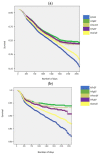Burden of Illness beyond Mortality and Heart Failure Hospitalizations in Patients Newly Diagnosed with Heart Failure in Spain According to Ejection Fraction
- PMID: 36983410
- PMCID: PMC10054096
- DOI: 10.3390/jcm12062410
Burden of Illness beyond Mortality and Heart Failure Hospitalizations in Patients Newly Diagnosed with Heart Failure in Spain According to Ejection Fraction
Abstract
Objective: The objective of this study was to describe the rates of adverse clinical outcomes, including all-cause mortality, heart failure (HF) hospitalization, myocardial infarction, and stroke, in patients newly diagnosed with HF to provide a comprehensive picture of HF burden.
Methods: This was a retrospective and observational study, using the BIG-PAC database in Spain. Adults, newly diagnosed with HF between January 2013 and September 2019 with ≥1 HF-free year of enrolment prior to HF diagnosis, were included.
Results: A total of 19,961 patients were newly diagnosed with HF (43.5% with reduced ejection fraction (EF), 26.3% with preserved EF, 5.1% with mildly reduced EF, and 25.1% with unknown EF). The mean age was 69.7 ± 19.0 years; 53.8% were men; and 41.0% and 41.5% of patients were in the New York Heart Association functional classes II and III, respectively. The baseline HF treatments included beta-blockers (70.1%), renin-angiotensin system inhibitors (56.3%), mineralocorticoid receptor antagonists (11.8%), and SGLT2 inhibitors (8.9%). The post-index incidence rates of all-cause mortality, HF hospitalization, and both combined were 102.2 (95% CI 99.9-104.5), 123.1 (95% CI 120.5-125.7), and 182 (95% CI 178.9-185.1) per 1000 person-years, respectively. The rates of myocardial infarction and stroke were lower (26.2 [95% CI 25.1-27.4] and 19.8 [95% CI 18.8-20.8] per 1000 person-years, respectively).
Conclusions: In Spain, patients newly diagnosed with HF have a high risk of clinical outcomes. Specifically, the rates of all-cause mortality and HF hospitalization are high and substantially greater than the rates of myocardial infarction and stroke. Given the burden of adverse outcomes, these should be considered targets in the comprehensive management of HF. There is much room for improving the proportion of patients receiving disease-modifying therapies.
Keywords: MACE; SGLT2 inhibitors; dapagliflozin; heart failure; myocardial infarction; stroke.
Conflict of interest statement
B.P., V.G., M.G., H.C. and P.R.H. are current employees of AstraZeneca, but this did not have an impact on data acquisition or the analyses of the results.
Figures




Similar articles
-
Evolution of economic burden of heart failure by ejection fraction in newly diagnosed patients in Spain.BMC Health Serv Res. 2023 Dec 1;23(1):1340. doi: 10.1186/s12913-023-10376-z. BMC Health Serv Res. 2023. PMID: 38041087 Free PMC article.
-
Healthcare resource utilization and costs among patients with heart failure with preserved, mildly reduced, and reduced ejection fraction in Spain.BMC Health Serv Res. 2022 Oct 8;22(1):1241. doi: 10.1186/s12913-022-08614-x. BMC Health Serv Res. 2022. PMID: 36209120 Free PMC article.
-
Characteristics, Outcomes, and Treatment of Heart Failure With Improved Ejection Fraction.J Am Heart Assoc. 2019 Mar 19;8(6):e011077. doi: 10.1161/JAHA.118.011077. J Am Heart Assoc. 2019. PMID: 30845873 Free PMC article.
-
First-line drugs inhibiting the renin angiotensin system versus other first-line antihypertensive drug classes for hypertension.Cochrane Database Syst Rev. 2018 Nov 14;11(11):CD008170. doi: 10.1002/14651858.CD008170.pub3. Cochrane Database Syst Rev. 2018. Update in: Cochrane Database Syst Rev. 2023 Jul 13;7:CD008161. doi: 10.1002/14651858.CD008161.pub3. PMID: 30480768 Free PMC article. Updated.
-
Indian Consensus on the Role and Position of Angiotensin Receptor-neprilysin Inhibitors in the Management of Heart Failure.J Assoc Physicians India. 2024 Sep;72(9):75-82. doi: 10.59556/japi.72.0664. J Assoc Physicians India. 2024. PMID: 39291524
Cited by
-
The value of cardiopulmonary comorbidity in patients with acute large vessel occlusion stroke undergoing endovascular thrombectomy: a retrospective, observational cohort study.BMC Neurol. 2024 May 7;24(1):155. doi: 10.1186/s12883-024-03660-w. BMC Neurol. 2024. PMID: 38714927 Free PMC article.
-
Cost-utility analysis of dapagliflozin for the treatment of symptomatic chronic heart failure in Spain.BMC Health Serv Res. 2025 Jul 24;25(1):974. doi: 10.1186/s12913-025-13089-7. BMC Health Serv Res. 2025. PMID: 40707910 Free PMC article.
-
Clinical and Economic Impact of a First Major Bleeding Event in Non-Anticoagulated Patients in Spain: A 3-Year Retrospective Observational Cohort Study.J Clin Med. 2025 Feb 19;14(4):1377. doi: 10.3390/jcm14041377. J Clin Med. 2025. PMID: 40004910 Free PMC article.
-
Current Role of SLGT2 Inhibitors in the Management of the Whole Spectrum of Heart Failure: Focus on Dapagliflozin.J Clin Med. 2023 Oct 27;12(21):6798. doi: 10.3390/jcm12216798. J Clin Med. 2023. PMID: 37959263 Free PMC article. Review.
-
Clinical and Economic Consequences of a First Major Bleeding Event in Patients Treated with Direct Factor Xa Inhibitors in Spain: A Long-Term Observational Study.J Clin Med. 2024 Jul 21;13(14):4253. doi: 10.3390/jcm13144253. J Clin Med. 2024. PMID: 39064293 Free PMC article.
References
-
- Gerber Y., Weston S.A., Redfield M.M., Chamberlain A.M., Manemann S.M., Jiang R., Killian J.M., Roger V.L. A contemporary appraisal of the heart failure epidemic in Olmsted County, Minnesota, 2000 to 2010. JAMA Intern. Med. 2015;175:996–1004. doi: 10.1001/jamainternmed.2015.0924. - DOI - PMC - PubMed
LinkOut - more resources
Full Text Sources
Research Materials
Miscellaneous

